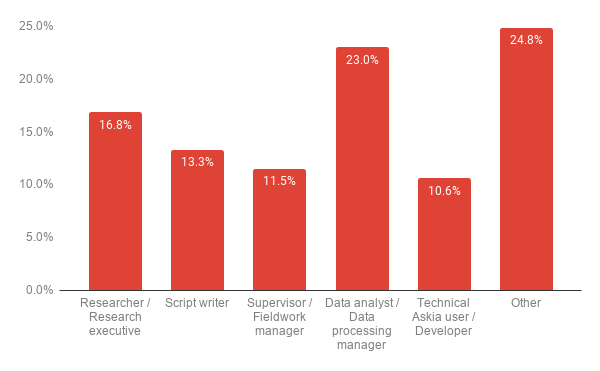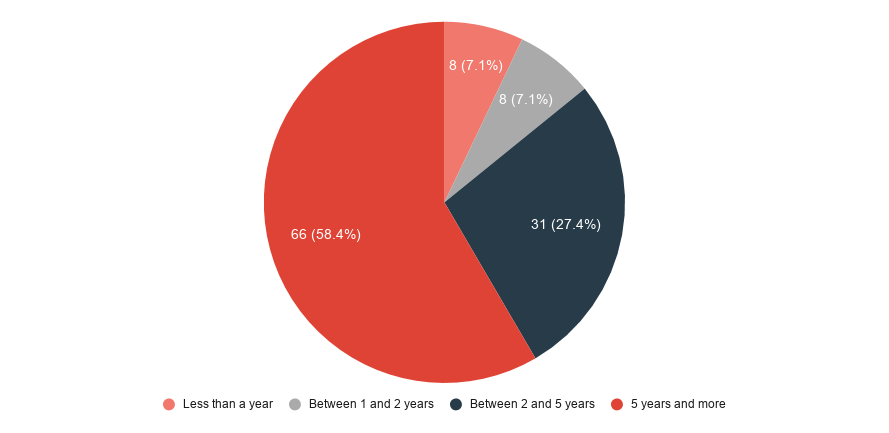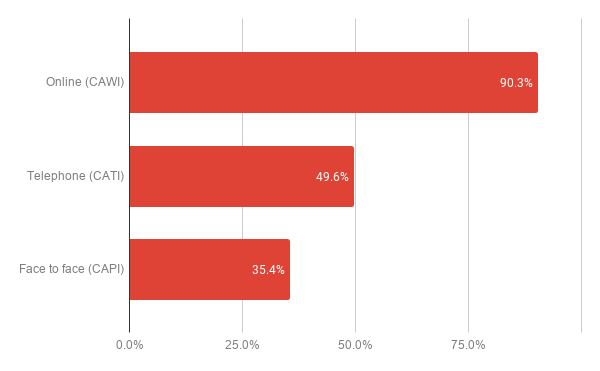
We couldn’t begin this new blogpost without thanking all the participants who have kindly taken part in the last Askia UX survey! We’d like to share some interesting (and some surprising) insights concerning different user profiles and behaviours.
In our previous article, we spoke about our decision to begin a user segmentation project. Our survey allowed us to enrich our knowledge about our users and discover usage patterns in our products. By focusing on the tasks that users tended to perform with our solutions, we have been able to define a user segmentation criteria.
110 users completed the survey with various job titles: the majority of them were data analysts and researchers.

Senior users have a fairly regular use of Askia
A large part of our respondents can be considered as “senior” users concerning their use of Askia, because they state having over two years of experience with Askia (85% of them).

The majority of our respondents are quite regular users as 40% of them state using Askia more than 16 hours a week!
Online surveys for the win!
90% of respondents confirm running CAWI surveys, but many of these users also run CATI surveys.

Survey testing, authoring & data analysis are the most frequently completed tasks according to our respondents
The most frequent tasks run are survey testing (for 44% of them), survey authoring (42%) and data analysis (39%). Survey authoring and data analysis are ranked as number 1 in terms of the most important tasks performed by our respondents.
Tasks are perceived as being more or less complex depending on user profiles
ADP & ADC creation/customisation is ranked as the most complex task to carry out. Ranking tasks based on complexity is difficult, as this varies for each user profile. Indeed, for some tasks (eg. survey authoring, survey testing, quota definition) the tasks seem to be easy to perform by researchers, while specific profiles, such as script writers or supervisors/fieldwork managers judge those tasks to be more complex.
Is it due to differing levels of technical requirement for the same task according to the user profile?
Task combinations go beyond job title and are specific to each user
We noticed that our respondents use different Askia solutions to accomplish their tasks. For example script writers can create/edit quota definitions (36% of them), setting up sample (20%) and data analysts can also perform survey publication (20%) or even survey authoring (19%). Moreover, task combinations are specific to users and require the use of different Askia products.
Tasks really seem to depend on the user’s organisation, rather than just being linked to a job title.
Next steps
Thanks to this survey we can now confirm that segmenting our users based on job titles alone is not so relevant, as we see that users perform tasks which can go far beyond their job titles. That is the main reason why segmenting by task seems much more relevant.
We now have key quantitative data concerning task frequency and complexity. This data will help us prioritize optimization projects based on these criteria. This will also help us recruit the right user targets for our upcoming UX interviews. We will need to explore each task and understand how they are performed by our users. Conducting specific user interviews per task will allow us to dig deeper into task contextualisation, help us understand how our users actually perform them and identify which pain points they might experience while carrying out a specific task.
This work is going to continuously help us improve the user experience on our products, so thanks again to all participants!

